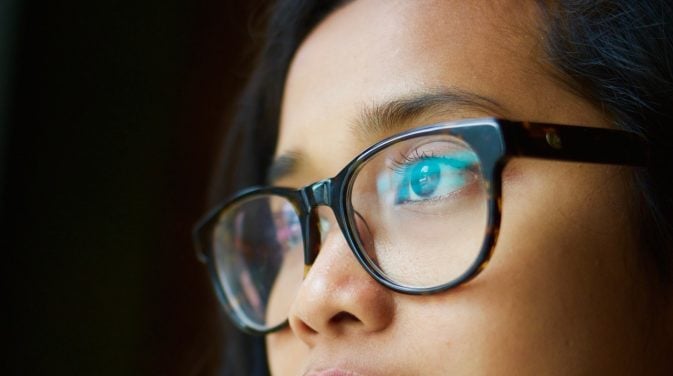Blue light glasses are among the hottest trends in eyewear. Popular eyewear companies, such as Warby Parker and Felix Gray, are selling lenses that claim to filter out blue light emitted from electronic devices to reduce eyestrain, headaches and sleep issues.
The ubiquitous bedtime use of laptops, smartphones and tablets can throw off our circadian rhythms, prompting people to look to a fairly unregulated market for a solution to block blue light.
But do blue light glasses really work?
The short answer: No.
Blue light glasses aren’t needed
According to an American Academy of Ophthalmology report, “it’s not necessary to spend money on special [eyewear] for computer use.”
“There’s really no evidence that [blue light glasses] help,” said Amir Mohsenin, M.D., Ph.D., assistant professor in the Ruiz Department of Ophthalmology & Visual Science at UTHealth‘s McGovern Medical School. “We don’t really have any data that supports blue blocking glasses as being better for your eyes when you’re using a computer. In fact, I would say that we don’t know if there’s any potential harm in wearing blue block glasses. It’s hard to recommend something without knowing more details about it.”
Studies have shown that blue wavelengths can disrupt the body’s natural circadian rhythm by suppressing melatonin production levels through certain non-image-forming photoreceptors in the eye called melanopsin, a type of photopigment in retinal cells. This helps us stay alert and focused during the daytime, but it can interfere with sleep.
However, a growing body of research is challenging the notion that blue light is bad. Scientists at the University of Manchester published a study in Current Biology that showed that yellow light disrupted sleep patterns in mice more than blue light.
“The reality is that most of the problems we’re having with computers and eyestrain isn’t from blue light; it’s from how we use the computers,” said Mohsenin, who also treats patients at the Robert Cizik Eye Clinic and Memorial Hermann-Texas Medical Center. “We’re spending more and more time in front of the computer screens. There are things you can do to minimize eyestrain, but as ophthalmologists, we’re not recommending blue blocking glasses.”
Focus on reducing eyestrain
To alleviate eyestrain, Mohsenin said to follow the 20/20/20 rule: Every 20 minutes, look at an object approximately 20 feet away for 20 seconds. In addition, make sure you’re sitting 25 inches or an arm’s length away from the computer screen and tilt it downward to reduce glare. Room lighting is also important; adjust the lighting so that you’re not staring at a bright screen in a dark room.
Another culprit of eyestrain is staring at our devices without blinking for long periods of time.
“When you’re focusing on something, your blink rate can drop by 50 percent or more,” Mohsenin said, adding that artificial tears can help. “Blinking is necessary for lubrication of the surface of the eye. When the surface isn’t lubricated, you can become symptomatic. Normally, we blink around 15 or more times a minute. You can go down to 7 times pretty easily when you’re staring at your computer screen.”
Ultimately, instead of spending money on blue light glasses, Mohsenin said to “take any marketing for blue light glasses with a grain of salt and talk it over with your ophthalmologist.”
“That’s the best thing you can do,” he said. “Get an eye exam to make sure you don’t have any other issues with your eyes and ask your ophthalmologist what they recommend because your eyestrain could be something else that needs actual treatment.”


